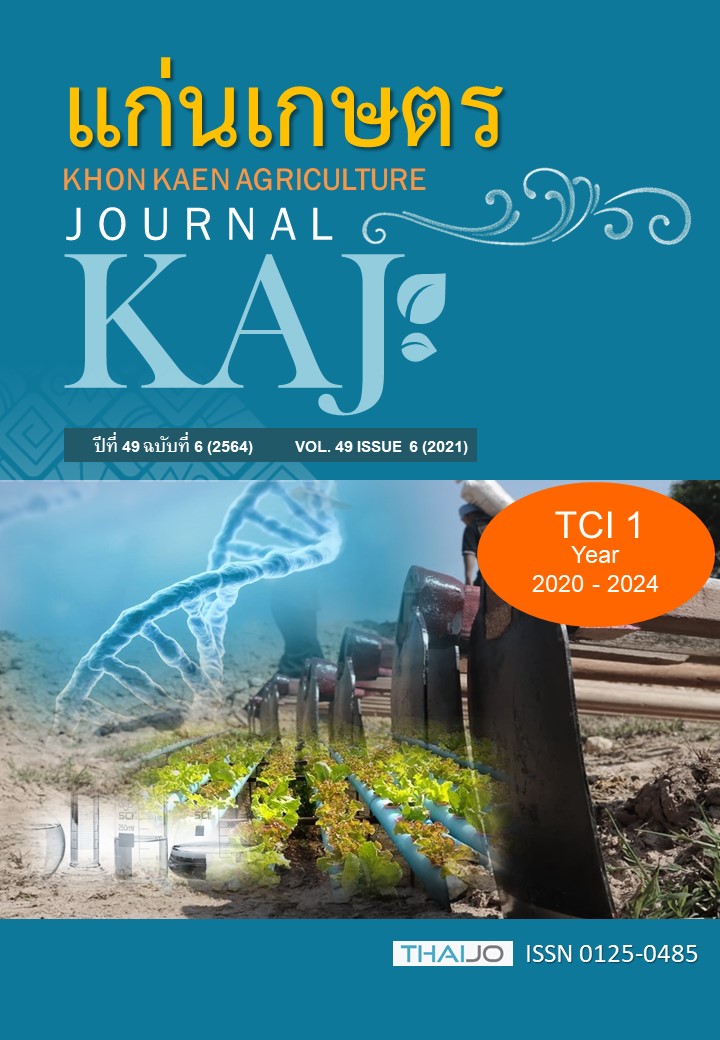ผลของการทำไพรมิงต่อรูปแบบการดูดอุ้มน้ำ และความงอกของเมล็ดพันธุ์ข้าว
Main Article Content
บทคัดย่อ
ความงอก และความแข็งแรงของเมล็ดพันธุ์ข้าวมีผลต่อการตั้งตัวของต้นกล้า และการเจริญเติบโตของข้าว การทดลองนี้เป็นการศึกษาผลของแคลเซียมคลอไรด์ (CaCl2) โซเดียมคลอไรด์ (NaCl) น้ำส้มควันไม้ (WV) และกรดซาลิไซลิก (SA) ในการทำไพรมิง ต่อรูปแบบการดูดอุ้มน้ำ (water imbibition) และความงอกของเมล็ดพันธุ์ข้าว พันธุ์ชัยนาท 1 และพันธุ์สกลนคร ที่เก็บเกี่ยวใหม่ เมล็ดพันธุ์ที่เสื่อมคุณภาพเนื่องจากการเก็บรักษา 1 ปี และเมล็ดพันธุ์ที่เสื่อมคุณภาพเนื่องจากการเร่งอายุ โดยมีกรรมวิธีการไพรมิง 13 กรรมวิธี จำนวน 4 ซ้ำ คือ แช่เมล็ดในน้ำกลั่น (วิธีควบคุม), แช่เมล็ดในสารละลาย CaCl2 (ความเข้มข้น 0.1, 0.2, 0.5 mol) แช่เมล็ดในสารละลาย NaCl (ความเข้มข้น 0.1, 0.2, 0.5 mol) แช่เมล็ดในสารละลาย WV (ความเข้มข้น 1:500, 1:300 และ 1:200 v/v; น้ำส้มควันไม้:น้ำ) และแช่เมล็ดในสารละลาย SA (ความเข้มข้น 0.0004, 0.0007, 0.0011 mol) ผลการทดลอง พบว่า ข้าวทั้ง 2 พันธุ์ มีรูปแบบการดูดอุ้มน้ำที่คล้ายคลึงกัน เมื่อไพรมิงเมล็ดพันธุ์ด้วยน้ำกลั่น WV และ SA เมล็ดพันธุ์งอกโดยปรากฏรากแรกเกิดในระยะเวลาใกล้เคียงกันที่ 20-36 ชั่วโมงหลังการแช่ ส่วนการไพรมิงเมล็ดพันธุ์ด้วย CaCl2 และ NaCl เมล็ดพันธุ์ใช้เวลาในการดูดอุ้มน้ำนานขึ้น นอกจากนี้ข้าวพันธุ์ชัยนาท 1 และสกลนคร ที่เป็นเมล็ดพันธุ์ใหม่และเมล็ดพันธุ์ที่เสื่อมคุณภาพเนื่องจากการเก็บรักษา 1 ปี เมื่อไพรมิงด้วย WV 1:200 v/v และ SA 0.0007 mol ทำให้เมล็ดพันธุ์งอกได้เร็วขึ้นเมื่อประเมินความความงอกที่ 5 วันหลังเพาะ ส่วนเมล็ดพันธุ์ที่เสื่อมคุณภาพเนื่องจากการเร่งอายุเมื่อประเมินความงอกที่ 5 วันหลังเพาะ เมล็ดพันธุ์ที่ไพรมิงด้วยสารละลาย และความเข้มข้นต่าง ๆ ทำให้เมล็ดพันธุ์งอกได้เร็วขึ้น และความงอกเพิ่มสูงขึ้นอย่างมีนัยสำคัญ เมื่อเปรียบเทียบกับเมล็ดแห้ง และการไพรมิงด้วยสารละลายเกลือที่ความเข้มข้นสูง ทำให้ข้าวทั้ง 2 พันธุ์มีความงอกลดลง
Article Details

อนุญาตภายใต้เงื่อนไข Creative Commons Attribution-NonCommercial-NoDerivatives 4.0 International License.
เอกสารอ้างอิง
กรมป่าไม้. 2545. คุณภาพเมล็ดไม้ และการพัฒนาแหล่งเมล็ดพันธุ์ไม้ป่า. เอกสารเผยแพร่ทางวนวัฒนวิทยา เล่มที่ 2. สำนักวิชาการป่าไม้. กรมป่าไม้.
ชานนท์ มณีรัตน์ ภาณุมาศ ฤทธิไชย และเยาวพา จิระเกียรติกุล. 2556. ผลของการ priming ด้วย salicylic acid และ folic acid ต่อความงอก ความแข็งแรง และการเจริญเติบโตของต้นกล้าผักบุ้งจีน. วิทยาศาสตร์และเทคโนโลยี. 21 (ฉบับพิเศษ 6): 511-519.
ดรุณี โชติษฐยางกูร สดุดี วรรณพัฒน์ และ อนันต์ พลธานี. 2555. การใช้น้ำส้มควันไม้เป็นสารแช่เมล็ดและฉีดพ่นทางใบในข้าวนาหว่าน: การทดสอบโดยเกษตรกร. แก่นเกษตร. 40 (ฉบับพิเศษ): 233-240.
ดรุณี โชติษฐยางกูร. 2559. ชีววิทยา และเทคโนโลยีเมล็ดพันธุ์. สาขาพืชไร่ ภาควิชาพืชศาสตร์ และทรัพยากรการเกษตร คณะเกษตรศาสตร์ มหาวิทยาลัยขอนแก่น.
นภาพร เวชกามา และพีรยศ แข็งขัน. 2561. การปรับปรุงคุณภาพของเมล็ดพันธุ์ด้วยเทคนิค Seed priming. เกษตรพระวรุณ. 15(1): 17-30.
บุญมี ศิริ. 2552. วิทยาการเมล็ดพันธุ์ Seed Technology. ภาควิชาพืชศาสตร์และทรัพยากรการเกษตร คณะเกษตรศาสตร์ มหาวิทยาลัยขอนแก่น.
บุญมี ศิริ. 2558. การปรับปรุงสภาพและยกระดับคุณภาพเมล็ดพันธุ์. ภาควิชาพืชศาสตร์และทรัพยากรการเกษตร คณะเกษตรศาสตร์ มหาวิทยาลัยขอนแก่น. โรงพิมพ์คลังนานาวิทยา. ขอนแก่น.
ภานุมาศ ฤทธิไชย และอติพร พิพัฒน์กรสกุล. 2551. ผลของวิธี hydropriming ต่อความงอกและความแข็งแรงของเมล็ดพันธุ์ผักชี. แก่นเกษตร. 36: 235-240.
Bewley, J.D., and M. Black. 1982. Physiology and Biochemistry of Seed in Relation to Germination. Vol. II. Seed Viability, Dormancy and Environmental Control. Springer-Verlay, New York.
Bouman, B., and L. Reyes. 2017. Continuing global partnership through rice. Rice today. Available: https://ricetoday.irri.org/continuing-global-partnership-through-rice/ Accessed Oct. 12, 2020.
Copeland, O.L., and M. B. McDonald. 2001. Principles of Seed Science and Technology. 4th Edition. Norwell, Massachusetts: Kluwer Academic Publishers.
Dashtmian, F.P., Hosseini M.K., and M. Esfahani. 2014. Improving rice seedling physiological and biochemical processes under low temperature by seed priming with salicylic. International Journal of Plant, Animal and Environmental Sciences. 4: 565–572.
Delouche, D.C. 1973. Precepts of seed storage. Proceedings of the Mississippi State Seed Processors Short Course.
Dissatian, A., J. Sanitchon, P. Pongdontri, N. Jongrungklang, and D. Jothityangkoon. 2018. Potential of wood vinegar for enhancing seed germination of three upland rice varieties by suppressing malondialdehyde production. Journal of Agricultural Science. 40(2): 371-380.
Duga, J.N., and R. Tufa. 2016. Effects of seed priming with sodium chloride on seedling performance of common bean (Phaseolus Vulgaris l.)under greenhouse condition.International Journal of Research – GRANTHAALAYAH. 4(6): 222-228.
Farooq, M., S. M. A. Basra, A. Wahid, N. Ahmad, and B. A. Saleem. 2009. Improving the drought tolerance in rice (Oryza sativa L.) by exogenous application of salicylic acid. Journal of Agronomy and Crop Science. 195: 237–246.
Fuller, M. P., J. H. Hamza, H. Z. Rihan, and M. Al-Issawi. 2012. Germination of Primed Seed under NaCl Stress in Wheat. International Scholarly Research Network.
Ghassemi-Golezani, K., A. A. Aliloo, M. Valizadeh, and M. Moghaddam. 2008. Effects of hydro and osmo-priming on seed germination and field emergence of Lentil (Lens culinaris Medik.). Notulae Botanicae Horti Agrobotanici Cluj-Napoca. 36: 29-33.
Halmer, P. 2004. Methods to improve seed performance in the field. pp. 125-165. In: R. L Benech-Arnold and R. A. Sanchez (eds.). Handbook of Seed Physiology: Applications to Agriculture. The Haworth Press, New York, USA.
Hasan, A., S. Ilyas, D. Sudarsono, and U.J. Sireger. 1998. Effect of invigoration treatment applied on different levels of seed vigor on physiological and biochemical changes in yard-long bean (Vigna unguiculata L. Walp.) seed. Thesis, Graduate School, Bogor Agricultural University.
ISTA. 1996. International Rules for Seed Testing: Rule 1996. International Seed Testing Association, Zurich. Switzerland.
Kang, G. Z., Z. X. Wang, K. F. Xia, and G. C. Sun. 2007. Protection of ultrastructure in chilling-stressed banana leaves by salicylic acid. Journal of Zhejiang University Science. B.8: 277- 282.
Kaya, M.D., G. Okcu, M. Atak, Y. CIKILI, and O. Kolsarici. 2006. Seed treatments to overcome salt and drought stress during germination in sunflower (Helianthus annuus L.). The European Journal of Agronomy. 24: 291–295.
Khan, H.A., C.M. Ayub, M.A. Pervez, R.M. Balal, M.A. Shahid, and K. Ziaf. 2009. Effect of seed priming with NaCl on salinity tolerance of hot pepper (Capsicum annuum L.) at seedling stage. Soil and Environment. 28: 81-87.
Murungu, F. S., P. Nyamugafata, C. Chiduza, L. J. Clark, and W. R. Whalley. 2005. Effects of seed priming and water potential on germination of cotton (Gossypium hirsutum L.) and maize (Zea mays L.) in laboratory assays. South African Journal of Plant and Soil. 22: 64-70.
Padares, D.E., T.W. Mew, and L.L. Ilag. 1996. Influence of moisture content and length of storage on fungal invasion of paddy rice. Biotropia 10: 1-13.
Rehman, H., S.M.A. Brasa, M. Farooq, N. Ahmad, and I. Afzal. 2011. Seed priming with CaCl2 improves stand establishment, yield and quality artteibutes in direct seeded rice (Oryza sativa). International Journal of Agriculture & Biology 13: 786-790.
Ruttanaruangboworn, A., W. Chanprasert, P. Tobunluepop, and D. Onwimol. 2017. Effect of seed priming with different concentrations of potassium nitrate on the pattern of seed imbibition and germination of rice (Oryza sativa L.). Integrative Agriculture. 16(3): 605–613.
Tavili, A., S. Zare, S.A. Moosavi, and A. Enayati. 2011. Effects of Seed Priming on germination characteristics of Bromus species under salt and drought conditions. American-Eurasian Journal of Agricultural & Environmental Sciences. 10(2): 163-168.
Van Staden, J., S.G. Sparg, M.G. Kulkarni, and M.E. Light. 2006. Post-germination effects of the smoke-derived compound 3-methyl-2H-furo[2,3-c]pyran-2-one, and its potential as a pre-conditioning agent. Field Crops Research. 98: 98–105.


